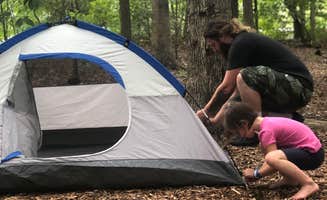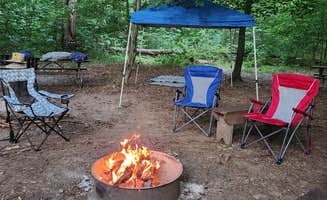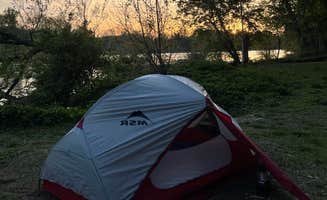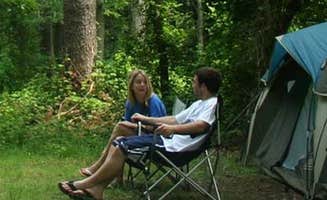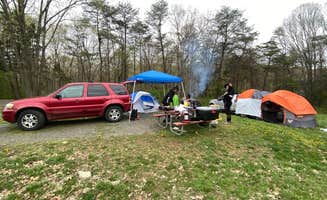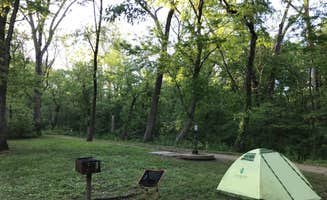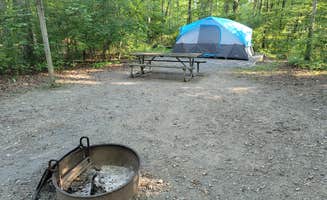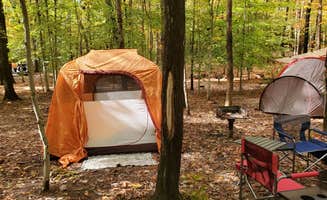Camping spots near Kensington, Maryland sit at an average elevation of 380 feet above sea level within the Piedmont region, characterized by gently rolling terrain and mixed hardwood forests. Seasonal conditions range from humid summers with temperatures often exceeding 85°F to mild springs and falls that provide the most comfortable camping weather. Most campgrounds in the area maintain primitive tent sites alongside developed RV spots with varying levels of hookups.
What to do
Trail exploration at Greenbelt Park: Only 10 miles from Kensington, this urban oasis offers several hiking loops through dense woodland. "The American Discovery Trail (ADT) passes through the park," notes camper Becky, highlighting connectivity to longer routes. Greenbelt Park Campground maintains 9 miles of marked trails suitable for all experience levels.
Water activities at Lake Fairfax Campground: This 20-acre lake provides fishing opportunities alongside seasonal paddleboat rentals from April through October. "There's a water park that is an extra cost which is fun for kids," explains reviewer Erin W. The campground includes access to both fishing areas and the Water Mine Family Swimmin' Hole water park with separate admission fees.
Disc golf at Pohick Bay Campground: The 18-hole disc golf course winds through wooded terrain and open fields. "Pohick Bay is my go-to weekend camping spot. Just a few miles outside DC, Pohick Bay is a hidden gem in the area. I'd recommend taking in a game of disc golf on their 18 hole course," suggests Rachel L. Course access is included with camping fees, and disc rentals are available at the park office for $5 per day.
What campers like
Metro accessibility: Several campgrounds provide straightforward public transportation options into Washington DC. At Greenbelt Park, campers appreciate the proximity to transit. "The METRO (only about 10 minutes with traffic)" offers convenient city access according to reviewer Crystal C., who adds "I spent about $10 per day on METRO versus $20-$40 on parking in the district area."
Year-round camping options: Bull Run Regional Park maintains camping facilities through all seasons. "We stayed at Bull Run Regional Campground on our visit to Washington DC. It was fall and the colors were gorgeous," notes Roberta K. The park's winter camping accommodates visitors during DC's less crowded tourist months with heated bathroom facilities.
Balanced urban-nature experience: Cherry Hill Park provides a combination of natural setting with urban convenience. "Surprisingly nice campground in a city. Lots of things for kids to do and access to bike trails outside of the complex," writes reviewer Jwalker. The property maintains wooded sites while providing scheduled transportation services to Washington DC attractions.
What you should know
Seasonal operations vary: Operating schedules differ significantly among area campgrounds. "Little Bennett Campground typically operates from April 1 to October 30," according to park information, limiting off-season options. Meanwhile, Ramblin' Pines stays open year-round, with one camper noting it's "open all year" and "clean."
Reservation requirements: Most campgrounds require advance booking, especially during peak periods. "Reserve online - this is a NO CASH facility which means you CANNOT pay upon arrival so you will have to do so online," warns Crystal C. about Greenbelt Park. Reservation windows typically open 6 months in advance for most parks in the region.
Noise considerations: Several campgrounds experience noise from nearby urban infrastructure. "There is a shooting range in the park. It is on a flight path for DCA. And, I66 is not that far away," reports Drew M. about Bull Run Regional Park. Similarly, at Burke Lake Park, one camper mentions "you can hear some traffic noise" due to suburban proximity.
Tips for camping with families
Activity scheduling: Little Bennett Campground offers numerous family-friendly amenities. "Great campground. A bit pricey, but has a full hookup loop. Other loops are tent only. Wonderful bath house. Lots of stuff to do," shares camper PattyD T. The park maintains a scheduled activity calendar including weekend nature programs and seasonal events.
Playground proximity: When booking sites, consider locations near play facilities. "We got a site on the inner loop and it backed to the playground and the bathhouse," notes Ben G. at Pohick Bay. "The site was spacious. We are tent campers but almost all our neighbors were in an RV or trailer."
Educational opportunities: Several parks incorporate historical and environmental education components. Bull Run Regional Park offers "a campfire complete with s'mores followed by hayrides," according to Bridget H., who adds that "my gkids enjoyed the nature scavenger hunt. You even get a prize when you finish."
Tips from RVers
Space considerations: RV sites vary significantly in size and leveling across the region. At Burke Lake Park Campground, "this is a NO CASH facility which means you CANNOT pay upon arrival so you will have to do so online." Sites accommodate smaller units, with most limited to 30 feet or less.
Utility hookups: Full-service sites are available at select locations. "We stayed at site D72 for 4 days. The sites are quiet, very spacious, level, and heavily wooded with 50A service, water and sewer hookup," shares Ray & Terri F. about Little Bennett Campground. Hookup availability differs widely between parks, with water and electric connections more common than sewer service.
Cellular coverage: Mobile service quality impacts remote work capabilities. "AT&T 5 MB/s w/o booster(1 bar), 8 MB/s with it(2 bars). There is no satellite coverage due to the heavy tree canopy. OTA TV was descent using an external omni antenna," reports Ray & Terri F. Most campgrounds have adequate cell service but limited WiFi, with Cherry Hill Park offering the most reliable connectivity.


